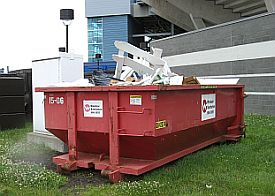What is Construction and Demolition Waste?
 Construction and demolition (C&D) waste is generated from construction, renovation, repair, and demolition of houses, large building structures, roads, bridges, piers, and dams. C&D waste is made up of wood, steel, concrete, gypsum, masonry, plaster, metal, and asphalt. C&D waste is notable because it can contain hazardous materials such as asbestos and lead. Estimates vary, but a commonly accepted estimate is that between 15% and 20% of municipal solid waste comes from construction and demolition projects.
Construction and demolition (C&D) waste is generated from construction, renovation, repair, and demolition of houses, large building structures, roads, bridges, piers, and dams. C&D waste is made up of wood, steel, concrete, gypsum, masonry, plaster, metal, and asphalt. C&D waste is notable because it can contain hazardous materials such as asbestos and lead. Estimates vary, but a commonly accepted estimate is that between 15% and 20% of municipal solid waste comes from construction and demolition projects.
Landfills accepting C&D waste have limited capacity. Many have already closed or are scheduled to close. Currently, most of the C&D waste generated in Connecticut is disposed of in out-of-state landfills and only an estimated 7% of this is reported recycled. These figures are only reflective of the waste which passes through Connecticut permitted solid waste facilities and reported to the DEEP. The 7% reported recycled rate does not include most of the clean fill generated and reused or recycled, scrap metal recycled from construction projects, materials directly hauled from a job site to an out-of-state recycling end market, or materials reused on site.
The following table summarizes the type of waste, legal classification, and examples:
| Type of Waste | Legal Classification In Connecticut | Examples |
|---|---|---|
| Landclearing debris | Bulky waste | Tree stumps, tree tops |
| Demolition waste (from buildings) |
Bulky waste | Concrete, wood, brick, plaster, roofing materials, wallboard, metals, carpeting, insulation |
| Construction waste (from buildings) |
Municipal solid waste | Pallets, wood scraps, wallboard, siding and roofing scraps, packaging, carpeting. Foam padding, insulation |
| Highway construction and demolition waste | Bulky waste, municipal solid waste | Asphalt, concrete, steel, related construction and demolition wastes, utility poles, railroad ties, brick, block, rock |
| Oversized MSW | Municipal Solid Waste | Furniture, furnishings, carpeting, rugs |
Connecticut General Statute Governing C & D Waste
The controlling statute concerning the management of construction and demolition waste in Connecticut is in Title 22a, Chapter 446d - specifically Section Sec. 22a-208x. This statue reads as follows:
Sec. 208x. Disposal options for certain types of bulky waste. (a) As used in this section and section 22a-208y, (1) "construction and demolition waste" means waste building materials and packaging resulting from construction, remodeling, repair and demolition operations on houses, commercial buildings and other structures, excluding asbestos, clean fill, as defined in regulations adopted under section 22a-209, or solid waste containing greater than de minimis quantities, as determined by the Commissioner of Environmental Protection, of (A) radioactive material regulated pursuant to section 22a-148, (B) hazardous waste as defined in section 22a-115, and (C) liquid and semiliquid materials, including, but not limited to, adhesives, paints, coatings, sealants, preservatives, strippers, cleaning agents, oils and tars; and (2) "processed construction and demolition wood" means the wood portion of construction and demolition waste which has been sorted to remove plastics, plaster, gypsum wallboard, asbestos, asphalt shingles, regulated wood fuel as defined in section 22a-209a and wood which contains creosote or to which pesticides have been applied or which contains substances defined as hazardous waste under section 22a-115.
(b) Construction and demolition waste which does not constitute processed construction and demolition wood may be disposed of at (1) any solid waste disposal area for which a permit has been issued for the disposal of bulky waste or (2) a municipal solid waste landfill. Processed construction and demolition wood may be disposed of at a resources recovery facility in accordance with section 22a-208y or at a permitted municipal solid waste landfill or any solid waste disposal area for which a permit has been issued for the disposal of bulky waste.
(c) Construction or demolition wood generated at a residence, other than wood that has been pressure-treated or that otherwise contains arsenic, furniture, mattresses and rugs or any such waste which has been crushed, chopped, shredded or otherwise processed shall be considered municipal solid waste and may be disposed of at any solid waste disposal area for which a solid waste permit has been issued for the disposal of bulky waste, or at a resources recovery facility or municipal solid waste landfill.
Questions?
Questions about construction and demolition debris may be directed to the DEEP Recycling Program at (860) 424-3366. For compliance assistance, call toll free at 1-888-424-4193. Business hours are between 8:30 a.m. and 4:30 p.m., Monday through Friday, except State Holidays.
Top of Page | Reduce/Reuse/Recycle | C&D Management
Content Last Updated February 5, 2020

